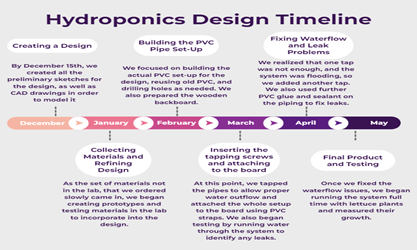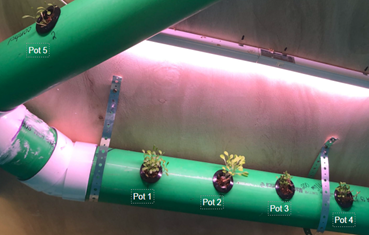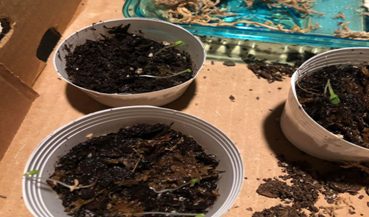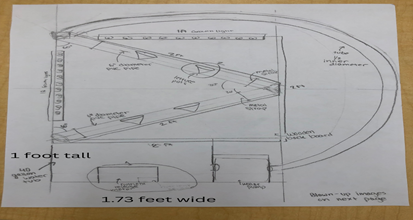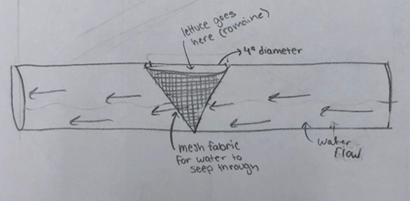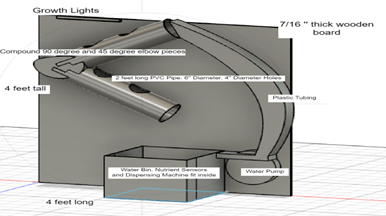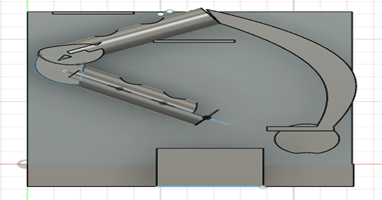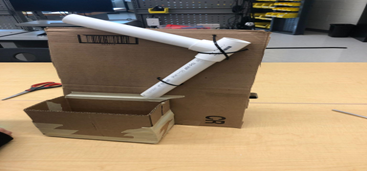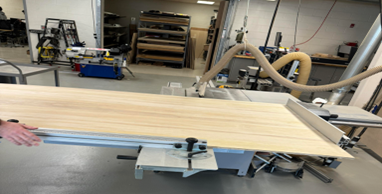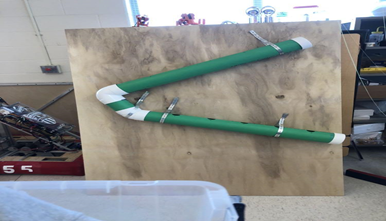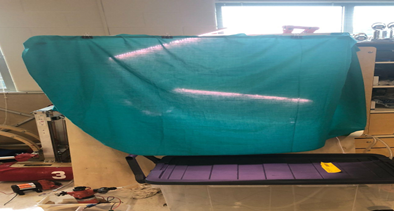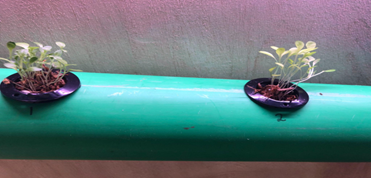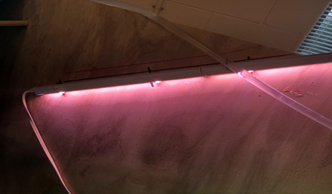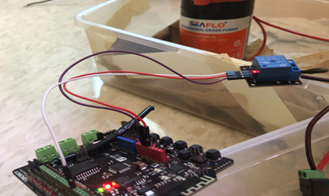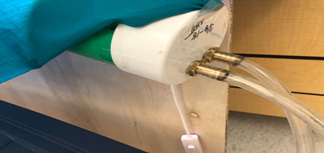Research Article
Engineering an Improved Hydroponics System
- S. Behera
- E. Kim
- A. O’Quinn *
- M. Pan
Engineering Senior Research 23-24, Duke University, United States.
*Corresponding Author: A. O’Quinn, Engineering Senior Research 23-24, Duke University, United States.
Citation: S. Behera, E. Kim, A. O’Quinn, & M. Pan. (2024). Engineering an Improved Hydroponics System. Clinical Case Reports and Studies, BioRes Scientia Publishers. 6(5):1-11. DOI: 10.59657/2837-2565.brs.24.162
Copyright: © 2024 A. O’Quinn, this is an open-access article distributed under the terms of the Creative Commons Attribution License, which permits unrestricted use, distribution, and reproduction in any medium, provided the original author and source are credited.
Received: July 20, 2024 | Accepted: August 05, 2024 | Published: August 10, 2024
Abstract
Much of the food insecurity within the United States is due to urban “food deserts” (large cities where many residents cannot access fresh, nutritious food). Within these cities, fresh food can be expensive to the point where most residents routinely resort to consuming highly processed fast food that lacks important nutritional qualities. In researching this phenomenon, it became clear that one of the solutions to this problem that could address long transportation times, the carbon emissions associated with such transportation, and the general lack of space in cities, would be hydroponic-based systems. Such systems grow crops without soil in compact, urban environments using artificial lighting. In order to test the effectiveness and efficiency of hydroponics-based systems, we developed a hydroponics-based system using already available materials and then tested it to determine if hydroponics could offer a sustainable alternative. Trying to use materials common to an engineering lab so as to be easier to build and replicate findings, we focused on adding PVC parts to a wooden frame to keep it in a 4-foot by 4-foot by 3-foot area. Although the system we created did require more energy than conventional farming, the hydroponics farm was able to successfully grow lettuce plants at a rate faster than Conventional Agriculture, demonstrating the merits of large-scale hydroponics agriculture.
Keywords: hydroponics; indoor garden, agriculture
Introduction
Research has shown that people with various healthy eating patterns were less likely to die from cardiovascular diseases, cancer, or respiratory disease compared to other participants in the same study (Shan et al., 2023). Despite the numerous health benefits, a healthy diet is not accessible in all places of the world or even in many urban areas of the United States. Food deserts are geographic locations where an absence of grocery stores within convenient traveling distance makes it difficult or impossible to access healthy food options. Most residents routinely resort to consuming highly processed fast food that lacks important nutritional qualities. The USDA estimates that about 19 million residents live in these low-access areas, demonstrating how prevalent urban food deserts are (USDA, 2022). Since many people living in food deserts would also not have access to a backyard, an indoor garden that waters itself via hydroponics presents a reasonable solution.
The benefits of hydroponic growth methods are demonstrated beyond the ability to cultivate food indoors. Traditional soil agriculture requires steady weather patterns, large labor costs, and immense land usage, all of which are threatened by climate change on Earth today. In addition to being heavily impacted by the erratic weather patterns caused by global warming, conventional outdoor agriculture contributes to as much as 20% of all greenhouse gas emissions, especially as a result of its low land efficiency and high reliance on fertilizers (Ahmed et al.). These issues with conventional agriculture stress the need for the adoption of a farming method that can be more land-efficient and require fewer fertilizers.
These issues stress the need for hydroponics-based farming. A hydroponics system works by using water infused with nutrients found in soil to create a body for crops to grow in to save on space and allow farming in a more controlled environment. According to Sharma et al. (2023), soilless culture conserves both water and land, using up to 90% less water and up to 80% less land than traditional agriculture. Controlled environment plant growth systems also deliver more accurate nutrient ions to the plant than soil-based agriculture, resulting in more efficient nutrient use, and reducing the use of excess fertilizers that contribute to climate change (Manthiram and Gribkoff). This technique allows for precise control over the plant's environment, including the nutrients, pH levels, and water content, producing biochemically and nutritionally enriched, high-yielding crops (Goh et al., 2023; Sharma et al., 2023).
There are seven main methods of hydroponic farming. Of these seven, the two most common are Nutrient Film Technique (NFT) and Deep-Water Culture (DWC) farming. In NFT systems, a thin film of nutrient-rich water flows over the plant roots, which are supported by a sloping trough or channel. The roots are exposed to the nutrient solution, and any excess solution is recirculated. NFT is suitable for crops with relatively small root systems, such as lettuce and herbs. DWC systems suspend plant roots in a nutrient solution, usually in a reservoir. An air pump is used to oxygenate the solution, and the roots are suspended in the nutrient-rich water. This method is often used for growing larger plants like tomatoes and cucumbers. A study that compared the efficiency of both methods concluded that the NFT system outperformed the DWC system in terms of energy-use efficiency, indicating higher growth and better energy savings associated with NFT systems (Gillani et al., 2023). By weighing this conclusion along with the fact that NFT systems are more suitable for growing our preferred plant, lettuce, we chose to use an NFT design for our research project.
When comparing the NFT system to a traditional agricultural system, a study found that the hydroponic yield of romaine lettuce outperformed the yield from the substrate (soil) method of cultivation (Dutta et al., 2023). In addition, another study using aggregate data for already existing hydroponic designs in Arizona in 2015 showed that using artificial lighting allowed lettuce plants to be able to be harvested multiple times in a year – as much as 10 times compared to conventional farming which usually includes just one harvest (Barbosa et al., 2015). The study further demonstrated that hydroponics produced 11 times as much food per square meter and used 13 times less water (Barbosa et al., 2015). However, the three studies also observed that hydroponic systems consumed more electricity due to the operation of sensors, microcontrollers, and actuators. For this reason, our design focuses on using gravity as much as possible to transport water, limiting energy usage. While our initial design does not include renewable energy, a main goal of future alterations is to attach the system to a solar power source to reduce energy waste. One other concern we hope to address is the price associated with building a hydroponics system. According to a 2022 study that compared the cost of building and maintaining a similar-sized hydroponics garden and conventional farm, the hydroponics garden costs 1.5 times as much to build and maintain (Gumisiriza et al., 2022). The study found that the main reason for this price difference was the need for expensive custom parts used in hydroponics (Gumisiriza et al., 2022). In order to address this issue, our main goal was to limit the use of expensive parts in this design, relying on PVC pipes and cheaper, smaller UV lights to reduce costs and to keep the total design below a cost of 500 US dollars.
In planning what the design would look like, existing research offered several facets to focus on in creating a successful design. Our main requirement was to demonstrate lettuce growth through a design using commonly available materials. We then compared this lettuce growth to lettuce grown at home in standard conventional farming conditions. In order to build the design, we created 4 different working gaps in each level of PVC pipe and secured the system to a wooden board along with artificial lighting to allow for greater compartmentalization. A successful design will provide regular water flow, will demonstrate nutrients successfully reaching the plants, and will be able to grow at least 4 different lettuce plants at a time.
Recognizing these requirements and issues to address, if this type of hydroponics-based design is further improved, we can improve food security for those in urban areas, saving on both space and water. This could allow individuals and community organizations to store hydroponic farms in community gardens, buildings, and roof-tops to produce even more fresh, accessible food even with limited space. An improved design will need to use less energy to be sustainable, but past precedent has demonstrated the space efficiency of hydroponics and the potential for future growth when used in conjunction with more renewable energy. For this reason, we will be initially focusing on using gravity as much as possible to transport water, in order to limit energy usage. In future research, we also hope to attach the system to solar-powered systems to reduce climate change impacts. If both of these are done properly, hydroponics may be able to replace conventional farming and provide a more efficient alternative to conventional farming, which is important as the US and global population continues to rise, increasing food demand, especially in rapidly growing urban areas. Thus, with this research, our goal is to demonstrate how compared to the conventional methods of farming that draw the nutrients out of the soil, hydroponics-based solutions offer a viable and effective alternative.
procedures
To create the hydroponics system, the first step was to create and secure a wooden backboard. This acts as the mainframe to attach the rest of the structures to and should be secure. We chose a 4-foot by 6-foot wooden board with 0.5-inch thickness as that was what was available, however, a board as small as 3.5-by 3-foot would have been sufficiently sized. The next step was to put the PVC piping together in a configuration shown in Appendix C. We used 4-inch PVC pipe parts as those were available, but any PVC with at least a 2.5-inch diameter and 6 feet of total length should work. To set up the PVC piping, we used a 90-degree and 45-degree elbow to keep both PVC lengths closer to horizontal as shown in Appendix A and modeled in Appendix B. Along the side of the PVC, we drilled a 1.5-inch diameter hole every 6.25 inches to provide space for the lettuce to grow. We then filled these gaps with planting cups containing Long fibered sphagnum moss (a moss that acts as a growth medium to retain water), as well as string coming out of the bottom so that water reaches the plant through capillary action. At the top of the piping, we drilled a half-inch diameter hole to allow our plastic tubing to pump water into the system. At the bottom, we drilled and tapped 2 holes to allow for the insertion of two taps (with half-inch outer diameters and ⅜-inch inner diameters). We then used metal PVC straps to attach the PVC to the board. Following this, we screwed in 20-watt plant growth lights one foot above where each of the lettuce plants would grow, which can be plugged into a wall outlet. We then set up a 40-gallon tank at the bottom (although future designs could use as little as a 5-gallon tank, and ran the piping intake and outtake to it. We then connected the piping to a sea-water pump that already existed in the lab and connected it to a wall outlet using a 5-volt, 5-amp AC to DC power adapter. We also added an ¼-inch restrictor into the piping coming out of the pump to further reduce water flow. In addition, we added an Arduino connected to a relayer to keep the pump on for two minutes at a time and then to turn it off, to prevent the pump from burning out. Following the completion of the main design, we then added a pre-mixed Nutrient Solution at a ratio of one teaspoon per quart of water. Appendix D provides images showing the design as a whole as well as some of the more specific designs. Appendix E includes the materials used to create the Hydroponics design.
Schedule
Testing methods
In order to test the effectiveness of the hydroponics garden, we grew lettuce from seeds and compared their growth to those being grown with conventional farming techniques. During a one-week period, Oakleaf lettuce was grown using both hydroponics and conventional farming. At the end of that week, plant height and width were both measured as well as color. The seeds used for both types of farming were taken from the same seed packet to reduce confounding variables. Height and width were both measured using a ruler after the testing period. Lettuce color was measured subjectively. Lettuce plants grown conventionally were brought into the research lab for measurements to ensure lighting was consistent.
Figure 1: Image of Hydroponics Plant Layout.
Figure 2: Image of Conventional Plant Layout
Note: Each pot includes multiple sprouts
Results
Table 1: Plant Growth from Seed after 1 week
| Pot Average | 1 | 2 | 3 | 4 | 5 |
| (Hydroponics) Height | 3.28 cm | 4.33 cm | 3.40 cm | 3.21 cm | 3.00 cm |
| Width | 0.85 cm | 0.95 cm | 0.80 cm | 1.05 cm | 1.18cm |
| Color | Green | Green | Light Green | Green | Green |
| (Conventional Farming) Height* | 2.50 cm | 3.25 cm | 2.42 cm | 2.75 cm | 3.18 cm |
| Width | 0.30 cm | 0.15 cm | 0.22 cm | 0.25 cm | 0.28 cm |
| Color | Light Green | Green | Green | Green | Green |
Discussion
When comparing the results for Oakleaf Lettuce grown using hydroponics compared to lettuce grown using Conventional Farming, we do see a significant increase in plant height as well as plant width, indicating accelerated growth. In contrast to the hydroponically grown lettuce that sprouted after just five days, the conventionally farmed lettuce sprouted on the seventh day. This is consistent with existing studies which found that in contrast to hydroponically grown lettuce that matures in just 30 days, conventionally grown lettuce takes 60 to 80 days to mature (Lugo, 2023). To test the significance of these results, we used a one-sided 2-sample t-test for a difference in means at the 0.05 significance level. Using that t-test, we were able to demonstrate that there is a significant difference in height as well as width between the hydroponically grown and conventionally grown lettuce, with a p-value of 0.0307 for height and 1.98 * 10^-7 for width. This means that there would be a 3.07% and 0.0000198% chance of finding the above results if the null hypothesis (that lettuce in a hydroponic garden grows at the same rate as conventionally grown lettuce) was accurate. As both these probabilities are lower than 5%, we can reject the null hypothesis and verify that our hydroponics design can more quickly grow lettuce than conventional farming methods.
Recognizing the success, we had in creating an effective hydroponic design, there are several unexpected problems we ran into that limited our ability to test the hydroponics that should be considered in advance of building any future hydroponic designs. One challenge for hydroponic designs using a tap to control water flow out of pipes rather than letting the water freefall is that the tap needs to be large enough to allow all water to flow out (to prevent flooding). However, the tap we initially used was too small compared to the amount of water flow being pumped in. We 3D printed a restrictor to limit water flow into the pipe, but that did not sufficiently limit water flow. This forced us to order two additional, larger taps, slowing down the overall building process. Another key issue hydroponic designs struggle with is the danger of leaks from connection points that are not perfectly sealed. This was a problem we dealt with as well, having to re-apply PVC glue several times to the same PVC intersection point and only finally being able to stop leaking using Marine Caulk. One other issue with our design that needed to be addressed was the functionality of the pump itself. During the testing phase, the pump burned out from excessive use, requiring a replacement, and setting back testing the machine. Ultimately, we discovered that the pump burned out from overheating, and required building an Arduino-based system to power the pump for two minutes and then turn it off for two minutes. These issues with the pump demonstrate the importance of stress-testing technology beforehand to find its limitations. We were able to find solutions to each of these issues that should be considered and implemented in future hydroponic designs.
A key challenge in building the hydroponics system was the limitation we placed on ourselves in designing the project – to use as many materials as possible already existing in the Engineering lab. For the main PVC part of the design, we used 4’’ PVC that had already been used in projects beforehand, significantly saving on total costs. This presented a set of issues as previous researchers had attached parts including the end caps improperly, choosing to use hot glue rather than PVC glue. Thus, when we began to test the PVC, significant amounts of water leaked out. Some of the parts of the PVC were unable to be used and had to be cut off in order to refit the system, and new PVC connection pieces had to be used. This unexpected redesign process took much longer than if we had just ordered custom parts and contributed to further leaks later on. Additionally, using a wooden board already existing in the lab for the frame restricted where different parts could be put on the board. The wood was not designed for hammering nails into and would frequently splinter, making it more challenging to hang parts from the board, forcing design changes.
An additional limitation in creating the design was that several of the key parts needed for the design took a long time to arrive. In particular, the plastic piping, essential to begin pumping water and testing water flow through the system, did not arrive until late January. This set back the testing process significantly and was a rate-limiting factor in being able to scale the size of the final design.
One further limitation was the inability to monitor the system over the weekends. Especially when the system was still slightly leaking, it could not safely be run over the weekends in case the leak grew worse, as this could make a significant mess. Thus, until fixes to the leak connecting the upper and lower pipes could be successfully implemented, lettuce could only be grown in the bottom pipe. This is because any lettuce left in the top pipe would dry up and die over the weekend.
Recognizing these limitations and challenges, there are several design improvements we would have incorporated if we attempted a hydroponics system again. The first change would be to order PVC instead of using old PVC parts and to use 3-inch instead of 4-inch PVC. Using a smaller pipe would reduce the amount of capillary action needed for water to move up the hydroponic wicks to reach the plants, allowing the pump used to remain off for longer periods of time. Additionally, we would use custom elbow pieces with larger angles (at least 150 degrees), in order to include more PVC pipes on the board. This would allow for growing more lettuce in the same amount of time, increasing total yield further compared to conventional farming without reducing the rate of growth. One other change we would choose to make would be to have multiple wooden boards connected to each other with PVC piping on both sides, all using the same water supply tank. By replicating the design process, we have done so far and connecting all the water outlets and inlets to one central bin, we could grow even more lettuce and take further advantage of the relatively thin width of the farm.
Conclusion
The purpose of this experiment was to test the effectiveness of Hydroponic Systems for growing lettuce as compared to Conventional Farming Methods. An additional purpose of this experiment was to demonstrate the feasibility of building a Hydroponics design mostly out of parts existing in the lab. For our experiment to be successful, we must meet the requirements of creating regular water flow and growing at least four lettuce plants at once with minimal human intervention. Based on these requirements, we were able to successfully complete our goal of creating a working Hydroponics Garden. We pumped water to the plants at two-minute intervals, allowing proper hydration and access to nutrients. Additionally, we were able to grow lettuce in each of seven different plastic inserts, taking a sample of five cups to compare with the lettuce grown by conventional farming. Although we were unable to conduct the experiment long enough for the lettuce to reach full maturity, the accelerated lettuce growth in the hydroponics system indicates that lettuce plants grown within the system would reach maturity in the predicted 30-day time frame and that hydroponics systems are more effective than conventional farming methods in terms of growing lettuce.
As urban food insecurity persists around the world, continuing to design and improve hydroponics systems will continue to be important. One suggestion for further research would be to combine existing hydroponics designs with solar panels and batteries to create a more sustainable and energy-efficient design. Especially as the pump used for this design only needed five volts and five amperes of current (only 25 watts of power), and each light used only 20 watts, a standard 300-watt solar panel is more than capable of producing sufficient power both for the pump and lighting (Allen, 2022). This could offset the higher energy costs of hydroponics and make full-scale implementation more feasible. One other suggestion for future research would be to test how hydroponics contrasts with conventional farming methods after many years of harvesting crops in the same location. We only tested our hydroponics system for a short amount of time, having not seen a lettuce plant reach full maturity. By extending the experiment, problems regarding how the hydroponics system affects the health and nutrient intake of the lettuce or solutions to longstanding complications of conventional farming could arise. For example, one concern with conventional farming is soil degradation after growing the same crop many years in a row (Kibblewhite et al., 2007). Thus, it would be valuable to compare how hydroponic crop yields change over time as compared to conventional crop yields. Another area for future research that should be explored is what different crops would work well in a hydroponics system, and which benefit the most compared to conventional farming. This study demonstrated how lettuce grew much more quickly in a hydroponic environment than in a conventional farming environment, but it would be valuable to explore how different crops respond to hydroponics. Especially as crops like corn, rice, and wheat are consumed in much higher contents globally, it would be valuable to test if hydroponics designs could be modified to support growing those types of crops and how relatively efficient hydroponics would be (Bradley and Marulanda, 2001).
Appendix A
Initial Design Sketches
Figure A1: Initial Sketch of the Design
Figure A2: Original Designs for Lettuce Pots with Romaine Lettuce
Appendix B: CAD Files Designs for the Project (Fusion File Linked)
Figure B1: 3D View of the CAD Sketch of the original Design
Figure B2: Front View of Original CAD Design
Appendix C: Steps of The Building Process
Figure C1: Initial Prototype
Figure C2: Cutting the Board
Figure C3: Attaching PVC to the Board
Appendix D: Final Design Images
Figure D1: Image of Overall Final Design
Figure D2: Early Lettuce Growth
Figure D3: LED Growth Lights
Figure D4: Water Pump Arduino Controller
Figure D5: Water Outtake Taps
Appendix E (Bill of Materials)
Table E1: Final Bill of Materials
| Material | Price per Component | Quantity | Total Cost | Link |
| 4’’ Diameter PVC Pipe | $3.87 /ft. | 10 feet | $38.65 | link |
| Water Collection Tub | $44.98 | 1 | $44.98 | link |
| Nutrient Solution | $4.75/30 mL | 150ml | $23.75 | link |
| Water Pump with at least 10 feet range | $49.99 | 1 | $49.99 | link |
| UV Growth Lights | $7.50 | 4 | $29.99 | link |
| Plastic Tubing | $11.65 | 10 feet | $11.65 | link |
| 3/4 in. x 25 ft. 28-Gauge Galvanized Pipe Hanger Strap | $9.62 | 1 | $9.62 | link |
| 7/16’’ thick wooden board (at least 4 feet by 4 feet) | $14.90 | 1 board | $14.90 | link |
| 4-inch 90-degree elbow | $4.95/piece | 1 | $4.95 | link |
| 4-inch 45-degree elbow | $3.88/piece | 1 | $3.88 | link |
| (Marine Caulk) LifeSeal Sealant - White, 10.6 oz | $28.98/ bottle | 10.6oz | $28.98 | link |
| Arduino UNO R4 Minima | $22.54/ one | 1 | $22.54 | link |
| Female Power Plug to 2-Pin Terminal (Screw Down) Adapter | $6.44/ one | 1 | $6.44 | link |
| 3 Channel Relay Module | $3.36/ one | 1 | $3.36 | link |
| Oakleaf Lettuce Seeds (1 gram packet) | $2.99/ packet | 1 | $2.99 | link |
| 44’’ by 72’’ Solid Blue Fabric | $6.27 | 1 | $6.27 | link |
| Hydroponic Wicking Cotton Rope | $4.37 | 30 feet | $4.37 | link |
| PVC Primer and Glue | $10.94 | 8 oz of each | $10.94 | link |
| Sphagnum Moss | $7.97/bag | 432 in^3 | $7.97 | link |
| Total Cost: | $326.22 |
References
- Ahmed, J., et al. (2020). Agriculture and climate change: Reducing emissions through improved farming practices. McKinsey & Company.
Publisher | Google Scholor - Allen, N. (2022, May 19). How much power does a solar panel produce? Forbes Home.
Publisher | Google Scholor - Barbosa, G., Gadelha, F., Kublik, N., Proctor, A., Reichelm, L., Weissinger, E., et al. (2015). Comparison of land, water, and energy requirements of lettuce grown using hydroponic vs. conventional agricultural methods. International Journal of Environmental Research and Public Health, 12(6):6879-6891.
Publisher | Google Scholor - Bradley, P., & Marulanda, C. (2001). Simplified hydroponics to reduce global hunger. Acta Horticulturae, 554:289-296.
Publisher | Google Scholor - Dutta, M., Gupta, D., Sahu, S., Limkar, S., Singh, P., et al. (2023). Evaluation of growth responses of lettuce and energy efficiency of the substrate and smart hydroponics cropping system. Sensors, 23(4)-1875.
Publisher | Google Scholor - Gillani, S. A., Abbasi, R., Martinez, P., & Ahmad, R. (2023). Comparison of energy-use efficiency for lettuce plantation under nutrient film technique and deep-water culture hydroponic systems. Procedia Computer Science, 217 :11-19.
Publisher | Google Scholor - Goh, Y. S., et al. (2023). A meta-analysis: Food production and vegetable crop yields of hydroponics. Scientia Horticulturae, 321-112339.
Publisher | Google Scholor - Gumisiriza, M. S., Ndakidemi, P. A., & Mbega, E. R. (2022). A simplified non-greenhouse hydroponic system for small-scale soilless urban vegetable farming. MethodsX, 9:101882.
Publisher | Google Scholor - Lugo, J. (2023, March 25). How to grow lettuce from seeds: Complete guide. Gardeners Basics.
Publisher | Google Scholor - Kibblewhite, M. G., Ritz, K., & Swift, M. J. (2007). Soil health in agricultural systems. Philosophical Transactions of the Royal Society B: Biological Sciences, 363(1492):685-701.
Publisher | Google Scholor - Manthiram, K., & Gribkoff, E. (2021). Fertilizer and climate change. MIT Climate Portal. Massachusetts Institute of Technology.
Publisher | Google Scholor - Shan, Z., Wang, F., Li, Y., Baden, M. Y., Bhupathiraju, S. N., et al. (2023). Healthy eating patterns and risk of total and cause-specific mortality. JAMA Internal Medicine, 183(2):142.
Publisher | Google Scholor - Sharma, A., Hazarika, M., Heisnam, P., Pandey, H., Devadas, V., & Wangsu, M. (2023). Controlled environment ecosystem: A plant growth system to combat climate change through soilless culture. Crop Design, 100044.
Publisher | Google Scholor - USDA. (2022). Food access research atlas. Economic Research Service.
Publisher | Google Scholor

